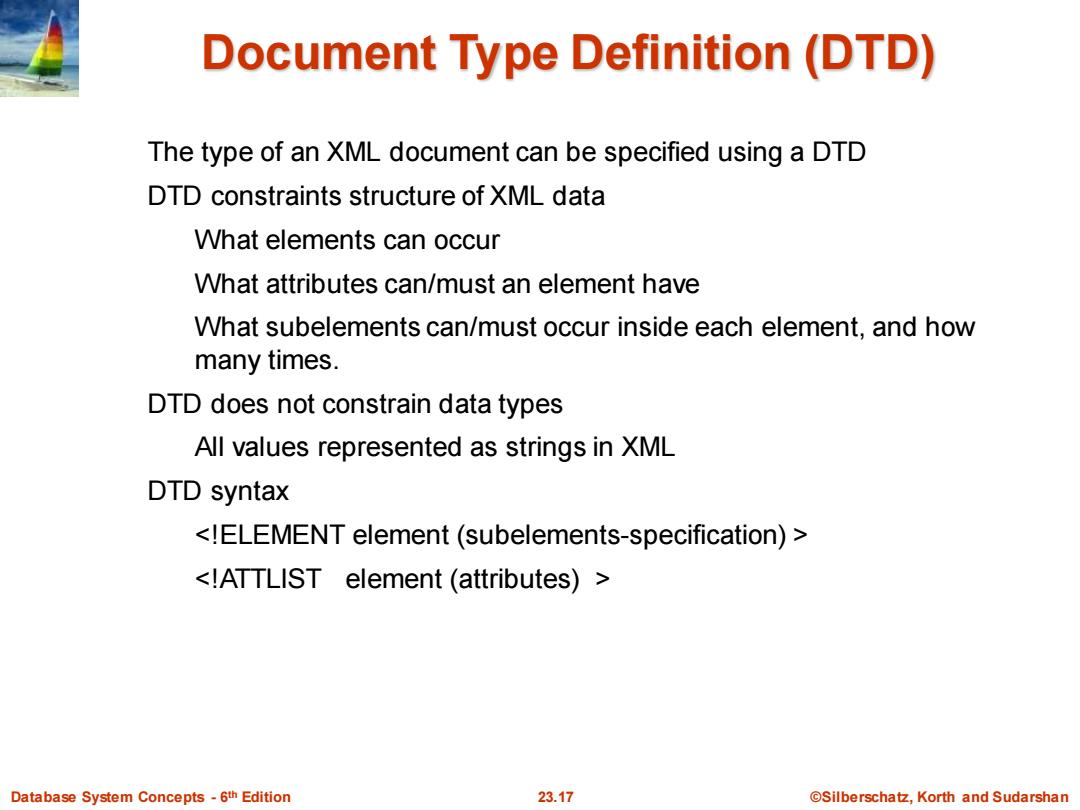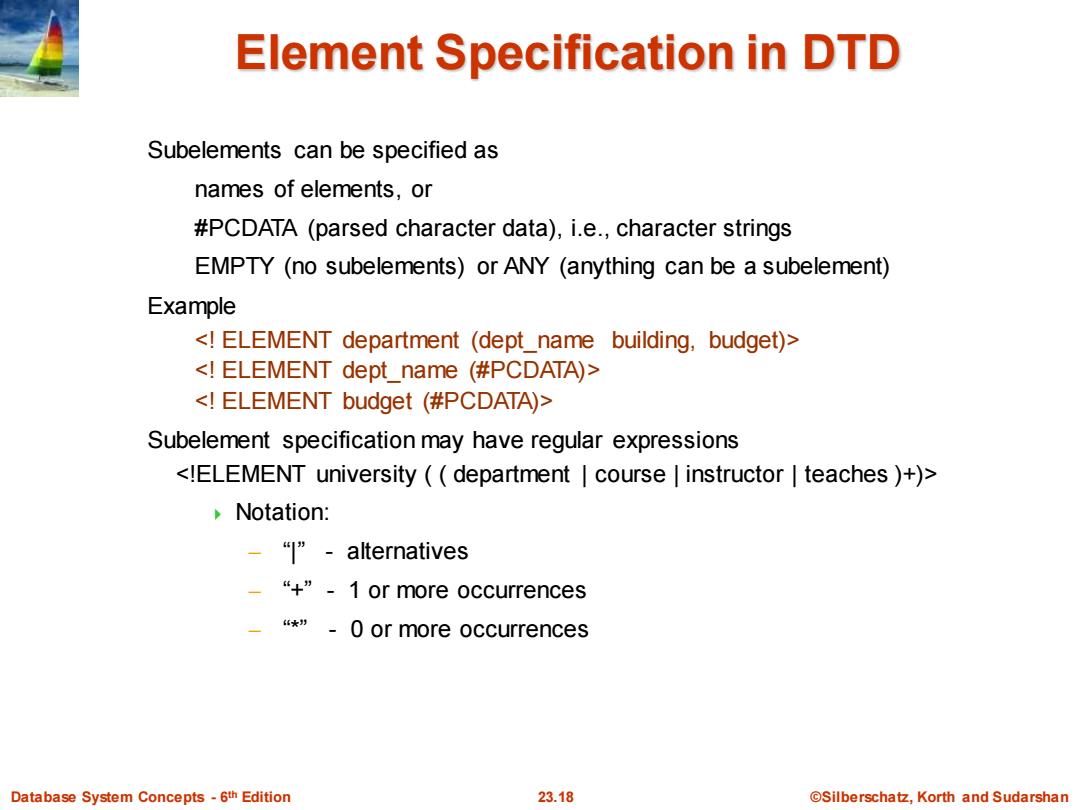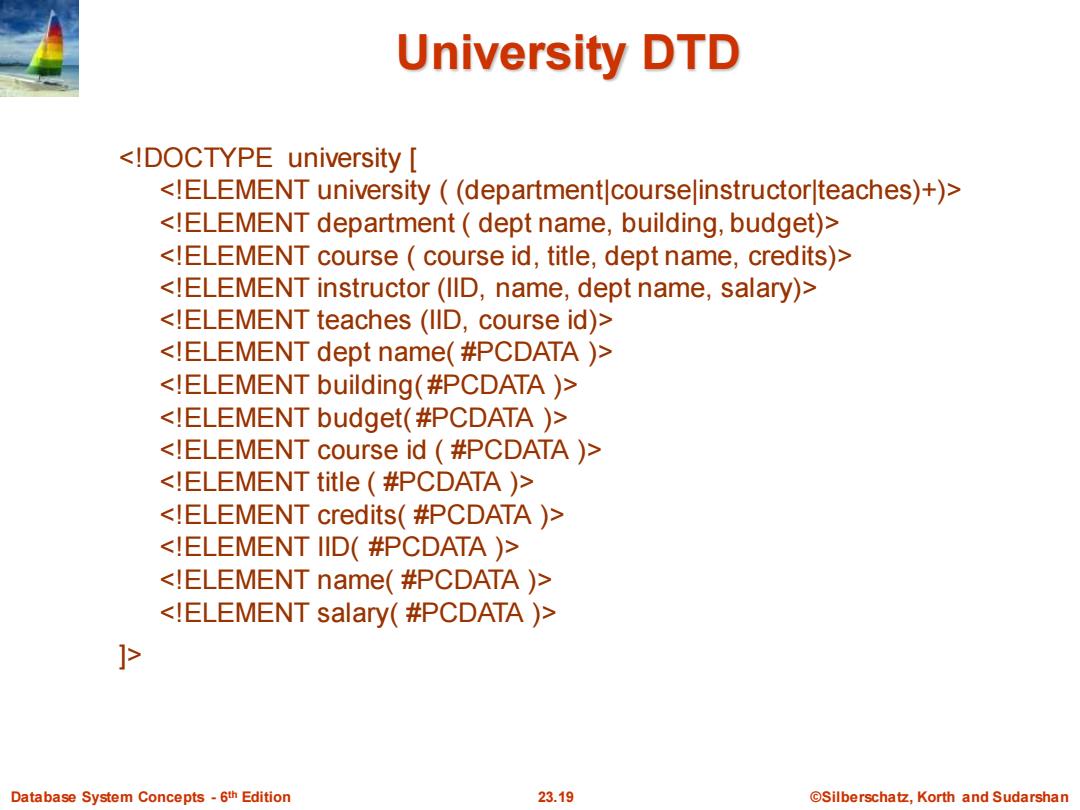
Document Type Definition(DTD) The type of an XML document can be specified using a DTD DTD constraints structure of XML data What elements can occur What attributes can/must an element have What subelements can/must occur inside each element,and how many times. DTD does not constrain data types All values represented as strings in XML DTD syntax <!ELEMENT element (subelements-specification)> <!ATTLIST element (attributes)> Database System Concepts-6th Edition 23.17 @Silberschatz,Korth and Sudarshan
Database System Concepts - 6 23.17 ©Silberschatz, Korth and Sudarshan th Edition Document Type Definition (DTD) The type of an XML document can be specified using a DTD DTD constraints structure of XML data What elements can occur What attributes can/must an element have What subelements can/must occur inside each element, and how many times. DTD does not constrain data types All values represented as strings in XML DTD syntax <!ELEMENT element (subelements-specification) > <!ATTLIST element (attributes) >

Element Specification in DTD Subelements can be specified as names of elements,or #PCDATA(parsed character data),i.e.,character strings EMPTY(no subelements)or ANY (anything can be a subelement) Example <ELEMENT department (dept name building,budget)> <ELEMENT dept name (#PCDATA)> <ELEMENT budget (#PCDATA)> Subelement specification may have regular expressions <!ELEMENT university (department course instructor teaches )+) Notation: -“”-alternatives “+”-1 or more occurrences “*”-0 or more occurrences Database System Concepts-6th Edition 23.18 @Silberschatz,Korth and Sudarshan
Database System Concepts - 6 23.18 ©Silberschatz, Korth and Sudarshan th Edition Element Specification in DTD Subelements can be specified as names of elements, or #PCDATA (parsed character data), i.e., character strings EMPTY (no subelements) or ANY (anything can be a subelement) Example <! ELEMENT department (dept_name building, budget)> <! ELEMENT dept_name (#PCDATA)> <! ELEMENT budget (#PCDATA)> Subelement specification may have regular expressions <!ELEMENT university ( ( department | course | instructor | teaches )+)> Notation: – “|” - alternatives – “+” - 1 or more occurrences – “*” - 0 or more occurrences

University DTD <!DOCTYPE university <!ELEMENT university ((department]course instructor teaches)+)> <!ELEMENT department dept name,building,budget)> <!ELEMENT coursecourse id,title,dept name,credits)> <!ELEMENT instructor(IID,name,dept name,salary)> <!ELEMENT teaches (IID,course id)> <!ELEMENT dept name(#PCDATA ) <!ELEMENT building(#PCDATA ) <!ELEMENT budget(#PCDATA ) <!ELEMENT course id (#PCDATA ) <!ELEMENT title (#PCDATA ) <!ELEMENT credits(#PCDATA ) <!ELEMENT IID(#PCDATA ) <!ELEMENT name(#PCDATA ) <!ELEMENT salary(#PCDATA ) P Database System Concepts-6th Edition 23.19 @Silberschatz,Korth and Sudarshan
Database System Concepts - 6 23.19 ©Silberschatz, Korth and Sudarshan th Edition University DTD <!DOCTYPE university [ <!ELEMENT university ( (department|course|instructor|teaches)+)> <!ELEMENT department ( dept name, building, budget)> <!ELEMENT course ( course id, title, dept name, credits)> <!ELEMENT instructor (IID, name, dept name, salary)> <!ELEMENT teaches (IID, course id)> <!ELEMENT dept name( #PCDATA )> <!ELEMENT building( #PCDATA )> <!ELEMENT budget( #PCDATA )> <!ELEMENT course id ( #PCDATA )> <!ELEMENT title ( #PCDATA )> <!ELEMENT credits( #PCDATA )> <!ELEMENT IID( #PCDATA )> <!ELEMENT name( #PCDATA )> <!ELEMENT salary( #PCDATA )> ]>